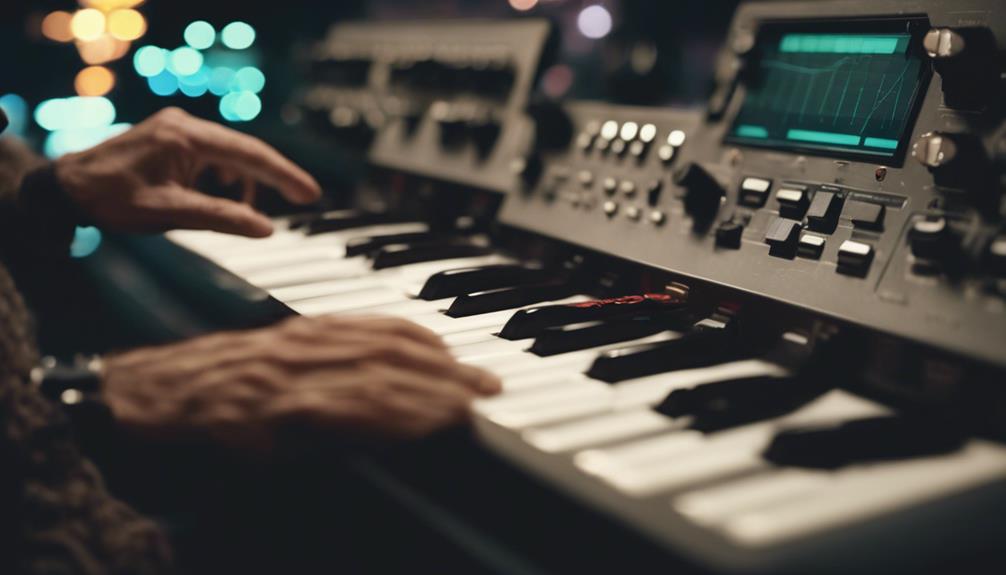Explore musical innovations like early music notation systems, piano invention by Cristofori for dynamic expression, and the metronome's impact on tempo control. Witness the evolution of symphonic form with Beethoven and Liszt, birth of electronic music with the Telharmonium, and the advent of the electric guitar by Beauchamp and Rickenbacker. Discover Les Paul's transformative multi-track recording, Leo Fender's iconic guitars, and Seth Lover's Humbucker pickups. Uncover the global influence of world music fusion and the impact of sampling technology on modern music production. These innovations have shaped music history in profound ways, influencing diverse genres and musical exploration.
Key Takeaways
- The development of the theremin in 1920 by Leon Theremin introduced the world's first electronic instrument.
- The Fairlight CMI in the late 1970s pioneered digital sampling and sequencing in music production.
- The introduction of MIDI in 1983 revolutionized electronic music composition and communication between musical instruments.
- The Chapman Stick, invented in the 1970s, expanded possibilities for tapping techniques and polyphonic playing styles.
- The Reactable, a tangible interface for music creation developed in 2005, offered a unique interactive and collaborative music-making experience.
Early Music Notation Systems
Early music notation systems underwent significant development from the use of neumes in Gregorian chants to the introduction of staff notation in the 11th century. Neumes, the earliest form of musical notation, were visual symbols placed above the text in Gregorian chants to indicate the shape and direction of the melody. However, neumes lacked precise information about pitch and rhythm, making it challenging to accurately reproduce music.
In the 11th century, Guido of Arezzo revolutionized music notation by introducing the staff, clefs, and solmization syllables. The staff provided a visual representation of pitch, while the clefs indicated specific pitch ranges. Additionally, the solmization syllables (do, re, mi, fa, sol, la, ti) helped singers identify pitches within a musical piece.
Guido's innovations, including the Guidonian hand mnemonic device, facilitated the shift from neumes to staff notation, allowing for more accurate representation of musical ideas and enhancing the communication of musical expression.
Invention of the Piano

The invention of the piano by Bartolomeo Cristofori in Italy around 1700 marked a significant milestone in musical history. His creation, initially named 'gravicembalo col piano e forte,' revolutionized music by introducing dynamic control and expression previously unattainable on keyboard instruments.
The piano's evolution over the centuries has had a lasting impact on music, shaping compositions and performances with its versatility and range.
Piano Evolution
In the domain of musical history, the invention of the piano by Bartolomeo Cristofori around 1700 marked a pivotal advancement in keyboard instruments. Cristofori's innovative design featured hammers that struck the strings, enabling musicians to achieve a dynamic range and expressiveness previously unattainable with instruments like the harpsichord and clavichord.
Over time, the piano underwent significant evolution. Changes in size, the addition of pedals, and adjustments in construction enhanced the instrument's tonal capabilities, making it a versatile tool for musicians across different genres.
The evolution of the piano not only revolutionized the way music was played but also contributed to the development of various musical styles and genres. From classical compositions to jazz improvisations and popular music performances, the piano became a fundamental instrument in the music landscape, showcasing its adaptability and enduring appeal.
Impact on Music
Cristofori's invention of the piano revolutionized music by introducing a versatile instrument capable of dynamic expression and range.
The piano, developed around 1700, amalgamated the best features of the harpsichord and clavichord, offering musicians a new level of expressiveness.
Unlike the harpsichord's plucking mechanism, Cristofori's piano incorporated a hammer mechanism that struck the strings, enabling performers to control volume and articulation.
This innovation propelled the piano into the spotlight, thanks to its ability to play both soft, gentle melodies and powerful, resonant chords.
The piano's adaptability and broad range quickly made it a staple in Western music, influencing the composition and performance techniques across various genres.
Over the centuries, the piano's impact on music has been profound, reshaping the landscape of musical expression and contributing to the evolution of diverse styles and forms.
Introduction of the Metronome

Johann Nepomuk Maelzel revolutionized musical performance in 1815 by patenting the metronome, a device essential for precise tempo control. The metronome provided musicians with a groundbreaking tool to measure and set the tempo of music accurately, ensuring a consistent rhythm throughout performances.
Inventor: Johann Nepomuk Maelzel, a German inventor and musician, patented the metronome in 1815, marking a significant advancement in music technology.
Function: The metronome consists of a pendulum or electronic mechanism that produces audible clicks at adjustable intervals, allowing musicians to follow a steady beat.
Usage: Renowned composers like Ludwig van Beethoven and Frédéric Chopin embraced the metronome for its ability to provide precise tempo indications in their compositions.
Impact: The introduction of the metronome revolutionized music practice and performance, influencing the way musical compositions were written and interpreted.
Development of the Symphonic Form

The evolution of the symphonic form traces back to the late 18th century, stemming from the classical sonata-allegro structure.
Composers like Beethoven played an essential role in expanding the symphonic form by introducing longer works and more complex structures, breaking away from the traditional norms of their time.
Liszt further revolutionized the symphonic form with his symphonic poems, which intertwined literature and music to create a new genre of orchestral storytelling, adding depth and narrative to the symphonic repertoire.
Mahler, known for his groundbreaking symphonies, pushed the boundaries of the symphonic form by incorporating vocal and choral elements, blending different musical styles and forms seamlessly.
In contemporary times, composers continue to innovate the symphonic form by integrating electronic elements and experimenting with non-traditional instruments, keeping the tradition alive while exploring new horizons in orchestral composition.
Birth of Electronic Music

Electronic music emerged in the early 20th century, marked by the invention of the Telharmonium, an electromechanical keyboard instrument. This innovation paved the way for the exploration of electronic sounds and music production techniques.
As the genre evolved over the years, several key milestones shaped its development:
- 1950s Experimentation: Pioneering composers like Karlheinz Stockhausen and Pierre Schaeffer explored tape manipulation and electronic sound experimentation, pushing the boundaries of traditional music composition.
- Moog Synthesizer: In the 1960s, Robert Moog's invention of the Moog synthesizer revolutionized electronic music production by offering a versatile tool capable of generating a wide array of sounds, influencing generations of musicians.
- Genre Evolution: Genres such as ambient, techno, house, and dubstep have emerged, each incorporating new technologies and production techniques to create distinct sonic landscapes.
- Contemporary Landscape: Today, electronic music remains a diverse and influential genre, with artists utilizing digital tools and software to craft innovative compositions that continue to push the boundaries of musical expression.
Rise of Jazz Improvisation

Jazz improvisation emerged as a groundbreaking musical technique in the early 20th century, allowing musicians to spontaneously create and innovate during live performances. This innovative approach transformed the landscape of music, particularly in the jazz genre.
Musicians such as Buddy Bolden, Louis Armstrong, and Jelly Roll Morton were pivotal in shaping and advancing jazz improvisation, showcasing their creativity and skill through on-the-spot creations of melodies, harmonies, and rhythms.
The essence of jazz improvisation often involved call and response patterns, where one musician's musical expression inspired responses from others in the band, creating a dynamic and interactive performance.
This spontaneous form of musical expression became a hallmark of jazz, adding a unique and personal touch to each live rendition. Jazz improvisation continues to be celebrated for its ability to captivate audiences and demonstrate the remarkable talents of musicians as they engage in real-time musical dialogue on stage.
Evolution of the Electric Guitar

The evolution of the electric guitar traces back to the 1930s when George Beauchamp and Adolph Rickenbacker introduced the first commercially successful model, revolutionizing the music industry.
Innovations in design, such as pickups and solid-body construction, paved the way for iconic guitars like the Fender Stratocaster and Gibson Les Paul, shaping the sound of genres like rock and roll, blues, and jazz.
These advancements in technology continue to drive the evolution of electric guitars, offering musicians endless possibilities for creativity and sonic exploration.
Guitar Amplification History
In the 1930s, George Beauchamp and Adolph Rickenbacker pioneered the invention of the first electric guitar, marking a significant milestone in the evolution of musical instruments. The introduction of pickups and amplifiers transformed acoustic guitars into electric ones, revolutionizing the music industry.
Les Paul's experiments in the 1940s were pivotal, leading to the creation of the solid-body electric guitar, which further enhanced the instrument's versatility and sound. The iconic Fender Telecaster and Stratocaster guitars emerged in the 1950s, cementing their place in music history and inspiring generations of musicians.
Innovations like distortion effects, wah-wah pedals, and feedback mechanisms have continued to shape the electric guitar's evolution, showcasing the ongoing creativity and technical advancements in the field of guitar amplification.
The history of guitar amplification is a fascinating journey filled with groundbreaking inventions and influential figures, often missed in traditional history classes but essential in understanding the development of modern music.
Inventors and Innovations
How did inventors and innovations shape the evolution of the electric guitar? The journey of the electric guitar's development is intricately tied to the creative minds and groundbreaking inventions of individuals like Les Paul and Leo Fender. Their pioneering work in the mid-20th century laid the foundation for the modern electric guitar landscape. Below is a table highlighting key inventors and innovations that have shaped the electric guitar's evolution:
| Inventor | Innovation | Impact |
|---|---|---|
| Les Paul | Multi-track recording & solid-body guitar | Revolutionized sound production & instrument design |
| Leo Fender | Telecaster & Stratocaster guitars | Popularized electric guitars in mainstream music |
| Seth Lover | Humbucker pickups | Reduced noise & enhanced tonal versatility |
| Jimi Hendrix | Use of effects pedals like the wah-wah pedal | Pushed boundaries of guitar sound experimentation |
| Roland Corporation | Development of digital modeling technology | Expanded tonal possibilities for guitarists |
These inventors and innovations have not only shaped the sound of music but also influenced generations of musicians and continue to inspire new advancements in electric guitar technology.
Impact on Music
With its electrifying presence in the music world, the evolution of the electric guitar has profoundly impacted musical genres and artists globally. The electric guitar, credited to George Beauchamp and Adolph Rickenbacker in the 1930s, revolutionized music by amplifying sound, enabling greater volume and distortion.
Innovations like Les Paul's solid-body electric guitar further popularized and diversified the instrument. The electric guitar played a pivotal role in the development of new music genres such as rock and roll, blues, and heavy metal. Its influence on music has been profound, shaping the sound and style of countless bands and musicians worldwide.
- The invention of the electric guitar in the 1930s by George Beauchamp and Adolph Rickenbacker revolutionized the music industry.
- Electric guitars allowed for amplified sound, greater volume, and distortion, transforming the way music was played and heard.
- Innovations like Les Paul's solid-body electric guitar contributed significantly to the popularity and versatility of the instrument.
- The electric guitar enabled the emergence of new music genres like rock and roll, blues, and heavy metal, shaping the musical landscape for generations to come.
Influence of World Music Fusion

The global music landscape has been greatly enriched by the influence of world music fusion, showcasing a harmonious blend of diverse musical traditions. World music fusion combines elements from various cultures, creating a rich tapestry of sounds and rhythms.
Artists draw inspiration from different musical traditions, incorporating instruments, melodies, and vocal styles to craft unique and innovative compositions. This fusion not only results in the creation of new and exciting music but also fosters cross-cultural collaborations that promote cultural exchange and appreciation.
Examples of world music fusion can be found in genres like jazz, which incorporates African rhythms, reggae blending with Latin beats, and pop music incorporating traditional Asian instruments. These instances highlight the interconnectedness of global musical traditions, emphasizing diversity and creativity in music.
Impact of Sampling Technology

Sampling technology has greatly transformed the music industry by revolutionizing the way artists incorporate existing recordings into their compositions. This innovation has had a profound impact on music production, allowing for the manipulation and integration of sampled audio to create unique sounds and textures.
Here are four key points highlighting the significance of sampling technology:
- Versatility: Sampling technology provides musicians with a versatile tool to experiment with different sounds and genres, pushing the boundaries of creativity in music production.
- Cross-Genre Adoption: From hip-hop to electronic dance music, sampling technology has been embraced across various music genres, showcasing its adaptability and widespread use in the industry.
- Legal Debates: The legality and ethics of sampling have sparked debates within the music industry, leading to copyright issues and legal battles as artists navigate the complexities of using sampled material.
- Continual Innovation: The ongoing development of digital sampling software and hardware continues to shape modern music production, offering endless opportunities for experimentation and innovation in the field.
Emergence of Music Videos

Emerging in the 1960s, the integration of visual elements into musical performances marked the early stages of the evolution of music videos. With the likes of The Beatles and The Rolling Stones pioneering this trend, music videos gradually became a significant aspect of the music industry. The launch of MTV in 1981 propelled music videos into popular culture, transforming them into a powerful promotional tool for artists. This shift revolutionized marketing strategies, enhancing album sales and fostering deeper connections with fans. The 1980s and 1990s witnessed a golden age of music videos, characterized by groundbreaking productions from iconic artists such as Michael Jackson, Madonna, and Prince. In the digital age, streaming platforms have reshaped the landscape of music videos, making them more accessible and shareable than ever before. This evolution underscores the enduring influence and relevance of music videos in shaping the music industry.
| Music Videos | Evolution | Impact |
|---|---|---|
| Visual elements integration | Popularization via MTV | Marketing tool |
| Golden age of 80s and 90s | Digital transformation | Accessibility |
Frequently Asked Questions
When Did Stuff You Missed in History Class Start?
Stuff You Missed in History Class started as a podcast in January 2008. Holly Frey and Tracy V. Wilson are the hosts of the podcast, which has released over 1,000 episodes covering a wide range of historical topics and figures.
With a large following, the podcast continues to produce new episodes regularly, educating listeners about fascinating historical events and figures that may have been overlooked in traditional history lessons.
Who Is Tracy V. Wilson?
Tracy V. Wilson is a seasoned podcaster known for her work on 'Stuff You Missed in History Class.' With a background in journalism and a talent for storytelling, she brings historical topics to life.
Wilson's passion for history shines through as she uncovers lesser-known stories and figures, making the past accessible to a wide audience. Her dedication to thorough research has been instrumental in the podcast's success, captivating listeners with engaging narratives.
Conclusion
To sum up, the history of music is filled with innovative advancements that have shaped the way we listen and create music today.
From early music notation systems to the birth of electronic music, each development has played a vital role in the evolution of musical expression.
For example, the introduction of the piano revolutionized the way composers could convey their musical ideas, paving the way for future generations of musicians to explore new sounds and styles.









